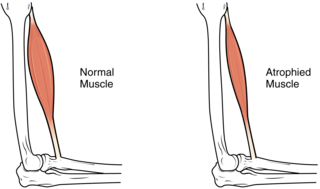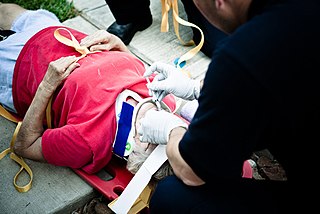Activities of daily living (ADLs) is a term used in healthcare to refer to people's daily self-care activities. Health professionals often use a person's ability or inability to perform ADLs as a measurement of their functional status. The concept of ADLs was originally proposed in the 1950s by Sidney Katz and his team at the Benjamin Rose Hospital in Cleveland, Ohio. Since then, a number of researchers have improved and added to the concept of ADLs. For example, many indexes that assess ADLs now include some measure of mobility.

Geriatrics, or geriatric medicine, is a medical specialty focused on providing care for the unique health needs of the elderly. The term geriatrics originates from the Greek γέρων geron meaning "old man", and ιατρός iatros meaning "healer". It aims to promote health by preventing, diagnosing and treating disease in older adults. There is no defined age at which patients may be under the care of a geriatrician, or geriatric physician, a physician who specializes in the care of older people. Rather, this decision is guided by individual patient need and the caregiving structures available to them. This care may benefit those who are managing multiple chronic conditions or experiencing significant age-related complications that threaten quality of daily life. Geriatric care may be indicated if caregiving responsibilities become increasingly stressful or medically complex for family and caregivers to manage independently.

Sarcopenia is a type of muscle loss that occurs with aging and/or immobility. It is characterized by the degenerative loss of skeletal muscle mass, quality, and strength. The rate of muscle loss is dependent on exercise level, co-morbidities, nutrition and other factors. The muscle loss is related to changes in muscle synthesis signalling pathways. It is distinct from cachexia, in which muscle is degraded through cytokine-mediated degradation, although both conditions may co-exist. Sarcopenia is considered a component of frailty syndrome. Sarcopenia can lead to reduced quality of life, falls, fracture, and disability.

Fall prevention includes any action taken to help reduce the number of accidental falls suffered by susceptible individuals, such as the elderly (idiopathic) and people with neurological or orthopedic indications.

Gerontological nursing is the specialty of nursing pertaining to older adults. Gerontological nurses work in collaboration with older adults, their families, and communities to support healthy aging, maximum functioning, and quality of life. The term gerontological nursing, which replaced the term geriatric nursing in the 1970s, is seen as being more consistent with the specialty's broader focus on health and wellness, in addition to illness.

Frailty is a common geriatric syndrome that embodies an elevated risk of catastrophic declines in health and function among older adults. Frailty is a condition associated with ageing, and it has been recognized for centuries. It is a marker of a more widespread syndrome of frailty, with associated weakness, slowing, decreased energy, lower activity, and, when severe, unintended weight loss. As a frequent clinical syndrome in the elderly, various health risks are linked to health deterioration and frailty in older age, such as falls, disability, hospitalization, and mortality. Generally, frailty refers to older adults who lose independence. It also links to the experiences of losing dignity due to social and emotional isolation risk. Frailty has been identified as a risk factor for the development of dementia.

Balance in biomechanics, is an ability to maintain the line of gravity of a body within the base of support with minimal postural sway. Sway is the horizontal movement of the centre of gravity even when a person is standing still. A certain amount of sway is essential and inevitable due to small perturbations within the body or from external triggers. An increase in sway is not necessarily an indicator of dysfunctional balance so much as it is an indicator of decreased sensorimotor control.
Ageing is the process of becoming older. The term refers mainly to humans, many other animals, and fungi, whereas for example, bacteria, perennial plants and some simple animals are potentially biologically immortal. In a broader sense, ageing can refer to single cells within an organism which have ceased dividing, or to the population of a species.
The Barthel scale is an ordinal scale used to measure performance in activities of daily living (ADL). Each performance item is rated on this scale with a given number of points assigned to each level or ranking. It uses ten variables describing ADL and mobility. A higher number is associated with a greater likelihood of being able to live at home with a degree of independence following discharge from hospital. The amount of time and physical assistance required to perform each item are used in determining the assigned value of each item. External factors within the environment affect the score of each item. If adaptations outside the standard home environment are met during assessment, the participant's score will be lower if these conditions are not available. If adaptations to the environment are made, they should be described in detail and attached to the Barthel index.

Geriatric trauma refers to a traumatic injury that occurs to an elderly person. People around the world are living longer than ever. In developed and underdeveloped countries, the pace of population aging is increasing. By 2050, the world's population aged 60 years and older is expected to total 2 billion, up from 900 million in 2015. While this trend presents opportunities for productivity and additional experiences, it also comes with its own set of challenges for health systems. More so than ever, elderly populations are presenting to the Emergency Department following traumatic injury. In addition, given advances in the management of chronic illnesses, more elderly adults are living active lifestyles and are at risk of traumatic injury. In the United States, this population accounts for 14% of all traumatic injuries, of which a majority are just mainly from falls.
The Berg Balance Scale is a widely used clinical test of a person's static and dynamic balance abilities, named after Katherine Berg, one of the developers. For functional balance tests, the BBS is generally considered to be the gold standard.
The Timed Up and Go test (TUG) is a simple test used to assess a person's mobility and requires both static and dynamic balance.
Self-rated health refers to both a single question such as "in general, would you say that your health is excellent, very good, good, fair, or poor?" and a survey questionnaire in which participants assess different dimensions of their own health. This survey technique is commonly used in health research for its ease of use and its power in measuring health.
The Disability Rating Scale (DRS) was developed as a way to track a traumatic brain injury (TBI) patient from 'Coma to Community'. The scale was used to rate the effects of injury and decide how long recovery might take. The rating gives insight into the cognitive impairment of the individual with the TBI.
Aging has a significant impact on society. People of different ages and gender tend to differ in many aspects, such as legal and social responsibilities, outlooks on life, and self-perceptions. Young people tend to have fewer legal privileges, they are more likely to push for political and social change, to develop and adopt new technologies, and to need education. Older people have different requirements from society and government, and frequently have differing values as well, such as for property and pension rights. Older people are also more likely to vote, and in many countries the young are forbidden from voting. Thus, the aged have comparatively more, or at least different, political influence.
Anne B. Newman is an American scientist who researches epidemiology and gerontology. She received her Bachelor's, Master's and M.D. degrees from the University of Pittsburgh. Newman's primary focus of study is on atherosclerosis, longevity and what specific factors allow for people to thrive while aging. She focuses on geriatrics, gerontology and epidemiology. She was the first scholar to be awarded the Katherine M. Detre Endowed Chair of Population Health Science at the University of Pittsburgh. She has been listed on the annual ISI Web of Knowledge most highly cited scientists for 2015, as published by Thomson Reuters. Newman is a member of the Delta Omega Honor Society in Public Health and the American Epidemiology Society. Newman's highest qualifications are in geriatric medicine and her certification is through the American Board of Internal Medicine. Newman lives in Point Breeze Pennsylvania with her husband, Frank Kirkwood. She is a mother of three.
The Parallel Walk Test is a quick and simple quantitative measuring tool for balance during walking and could be a useful tool in clinical settings for assessing balance before and after treatments and to discriminate high fall risk potential.
Limits of Stability (LoS) are a concept in balance and stability, defined as the points at which the center of gravity (CoG) approaches the limits of the base of support (BoS) and requires a corrective strategy to bring the center of mass (CoM) back within the BoS. In simpler terms, LoS represents the maximum distance an individual can intentionally sway in any direction without losing balance or needing to take a step. The typical range of stable swaying is approximately 12.5° in the front-back (antero-posterior) direction and 16° in the side-to-side (medio-lateral) direction. This stable swaying area is often referred to as the 'Cone of Stability', which varies depending on the specific task being performed.
Dynapenia is the loss of muscular strength not caused by neurological or muscular disease that typically is associated with older adults.
The Thai frailty index is the index commonly used to measure frailty in Thailand. It consists of 30 variables, including hypertension; diabetes; stroke; chronic obstructive pulmonary disease; chronic kidney disease, cognitive impairment; falls; dental problems; hearing problems; underweight; urinary or fecal incontinence; poor quality of life; depressed mood; fatigue; sleep problems, needing help for bathing; dressing, eating; walking; toileting; drug management; and doing housework. The index ranges from 0 to 30, 30 being the highest level of frailty. The index can be used to predict all-cause mortality.





